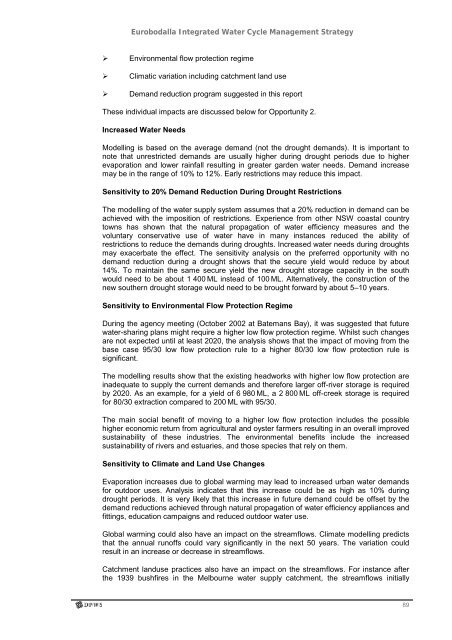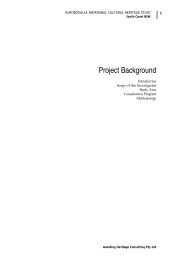Eurobodalla Integrated Water Cycle Management Strategy
Eurobodalla Integrated Water Cycle Management Strategy
Eurobodalla Integrated Water Cycle Management Strategy
You also want an ePaper? Increase the reach of your titles
YUMPU automatically turns print PDFs into web optimized ePapers that Google loves.
<strong>Eurobodalla</strong> <strong>Integrated</strong> <strong>Water</strong> <strong>Cycle</strong> <strong>Management</strong> <strong>Strategy</strong><br />
Environmental flow protection regime<br />
Climatic variation including catchment land use<br />
Demand reduction program suggested in this report<br />
These individual impacts are discussed below for Opportunity 2.<br />
Increased <strong>Water</strong> Needs<br />
Modelling is based on the average demand (not the drought demands). It is important to<br />
note that unrestricted demands are usually higher during drought periods due to higher<br />
evaporation and lower rainfall resulting in greater garden water needs. Demand increase<br />
may be in the range of 10% to 12%. Early restrictions may reduce this impact.<br />
Sensitivity to 20% Demand Reduction During Drought Restrictions<br />
The modelling of the water supply system assumes that a 20% reduction in demand can be<br />
achieved with the imposition of restrictions. Experience from other NSW coastal country<br />
towns has shown that the natural propagation of water efficiency measures and the<br />
voluntary conservative use of water have in many instances reduced the ability of<br />
restrictions to reduce the demands during droughts. Increased water needs during droughts<br />
may exacerbate the effect. The sensitivity analysis on the preferred opportunity with no<br />
demand reduction during a drought shows that the secure yield would reduce by about<br />
14%. To maintain the same secure yield the new drought storage capacity in the south<br />
would need to be about 1 400 ML instead of 100 ML. Alternatively, the construction of the<br />
new southern drought storage would need to be brought forward by about 5–10 years.<br />
Sensitivity to Environmental Flow Protection Regime<br />
During the agency meeting (October 2002 at Batemans Bay), it was suggested that future<br />
water-sharing plans might require a higher low flow protection regime. Whilst such changes<br />
are not expected until at least 2020, the analysis shows that the impact of moving from the<br />
base case 95/30 low flow protection rule to a higher 80/30 low flow protection rule is<br />
significant.<br />
The modelling results show that the existing headworks with higher low flow protection are<br />
inadequate to supply the current demands and therefore larger off-river storage is required<br />
by 2020. As an example, for a yield of 6 980 ML, a 2 800 ML off-creek storage is required<br />
for 80/30 extraction compared to 200 ML with 95/30.<br />
The main social benefit of moving to a higher low flow protection includes the possible<br />
higher economic return from agricultural and oyster farmers resulting in an overall improved<br />
sustainability of these industries. The environmental benefits include the increased<br />
sustainability of rivers and estuaries, and those species that rely on them.<br />
Sensitivity to Climate and Land Use Changes<br />
Evaporation increases due to global warming may lead to increased urban water demands<br />
for outdoor uses. Analysis indicates that this increase could be as high as 10% during<br />
drought periods. It is very likely that this increase in future demand could be offset by the<br />
demand reductions achieved through natural propagation of water efficiency appliances and<br />
fittings, education campaigns and reduced outdoor water use.<br />
Global warming could also have an impact on the streamflows. Climate modelling predicts<br />
that the annual runoffs could vary significantly in the next 50 years. The variation could<br />
result in an increase or decrease in streamflows.<br />
Catchment landuse practices also have an impact on the streamflows. For instance after<br />
the 1939 bushfires in the Melbourne water supply catchment, the streamflows initially<br />
89

















